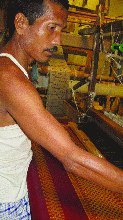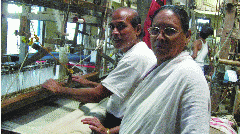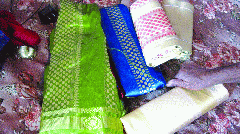Weavers of Sualkuchi The Spin in the Tale
Weavers of Sualkuchi The Spin in the Tale
 The approaching of Christmas in Meghalaya indicates that it is time for a class of skilled weavers in Assam’s silk village Sualkuchi to move the shuttles of their looms faster. It is during this time of the year that these weavers of this textile hub, about 150km off Meghalaya’s capital Shillong, get to display their weaving skill on specially designed looms to weave traditional Khasi female dresses with vibrant colours and motifs.
The approaching of Christmas in Meghalaya indicates that it is time for a class of skilled weavers in Assam’s silk village Sualkuchi to move the shuttles of their looms faster. It is during this time of the year that these weavers of this textile hub, about 150km off Meghalaya’s capital Shillong, get to display their weaving skill on specially designed looms to weave traditional Khasi female dresses with vibrant colours and motifs.
Sualkuchi, known for its centuries old tradition of weaving Assamese silk-products and having world recognition for its unique handloom products, is also successfully producing traditional Khasi silk textile for ages. The annual trade of the traditional Khasi dresses made of mulberry silk in this silk village now runs into several crores.
Hara Kumar Baishya, an entrepreneur living in Phulbari Pahar area near the River Police Station of Sualkuchi has seven handlooms at his home that produce, on an average, 200 pieces of Khasi women’s attire in Mulberry silk, a month. For generations, this traditional weaver’s family has been associated with the skill and today, on an average, he gets Rs 1,600/ for every piece of such silk products, he tells Eastern Panorama.
However, from July to October the market shows a downward trend and during the period entrepreneurs from Sualkuchi themselves have to travel to Shillong to deliver them to these traders.
“Two Khasi entrepreneurs named Mr. Owen and Ms. Mistian of Bara Bazar area in Shillong are regular customers of my silk-products,” Baishya says. Apart from them, the Mohini showroom in Police Bazaar has also a provision for displaying and selling traditional Khasi silk dresses produced by his weavers.
 On an average, from every kilogram of silk- yarn two sets of Khasi-dresses can be produced. The cost also involves wages of weavers and helpers, maintenance of the loom, providing shelter to weavers at home and others.
On an average, from every kilogram of silk- yarn two sets of Khasi-dresses can be produced. The cost also involves wages of weavers and helpers, maintenance of the loom, providing shelter to weavers at home and others.
Sualkuchi has around 100 such handlooms that produce traditional Khasi women’s dresses everyday. The looms have certain specifications. Weaving of Khasi dresses involves more skill with the use of extra warp weft designing system with supplementary jacquard. This practice is entirely restricted to Khasi dress weaving. The practice requires specific training for six to nine months for a weaver, in comparison to traditional Assamese handloom weavers.
Traditional motif of Khasi silk attire woven in Sualkuchi include mukhari, dhara, jensem, sintang with diamond and star designs. However, there is a growing demand for traditional Assamese motifs and designs including magar, kalsi, various plant, flower, animal and other geometrical designs that has made weavers to move for new experiments and blending, says Hemlata Baishya, who is the sister-in-law of Hara Kumar Baishya. Hemlata, a widow, has some looms to weave traditional Khasi women dresses.
How old is the tradition of weaving of Khasi dresses by weavers in Sualkuchi?
Hemlata has a prompt answer to give. Forty years back when she had made her first visit to her in-laws’ house immediately after her marriage to Meghnad Baishya, she was quite surprised to see those looms weaving traditional Khasi dresses.
“Then I was told by my in-laws that it was the father of my father-in-law Dharmaram Mahajan, who started weaving Khasi products in this house. So, you may easily imagine how old the tradition of weaving Khasi dresses in our family is,” she says.
Dhiren Das, one of the expert weavers engaged in Baishya’s enterprise since 1990, says that originally Khasi women were happy with whatever the weavers in Sualkuchi used to produce in their handlooms. However, now there is a wide-ranging demand for diversified designs, motifs, matching blouse pieces and matching shawls along with the main dress. This is a clear indicator of a changing market trend and weavers have to accept this challenge, he feels. A father of two college going children, Das used to work in the Department of Handloom and Textile in Meghalaya, before he joined Baishya’s enterprise as a weaver in the late eighties.
Dipankar Das, another resident of the locality, whose father Krishna Ram Das started weaving traditional Khasi dresses, is proud to be weaving silk products for the women of his neighbouring state.
 “Traders visiting here from Shillong say that from Meghalaya these products woven by our weavers, also travel abroad including the United States and UK, as Khasi NRIs residing in these countries pick them up for their collection. Such news really makes us proud,” he says.
“Traders visiting here from Shillong say that from Meghalaya these products woven by our weavers, also travel abroad including the United States and UK, as Khasi NRIs residing in these countries pick them up for their collection. Such news really makes us proud,” he says.
New market challenge
Despite this huge money flow in the trade, the steady market and the possibilities of growth and prosperity - this age-old Assam-Meghalaya non-formal textile trade has been showing a declining trend, and entrepreneurs like Baishya only foresee dark days with so many hurdles ahead.
One of the challenges he says is the skyrocketing hike in prices in raw materials like silk yarn and cocoons. This has posed a major challenge, not only to those who are engaged in weaving Khasi textile products, but to all those 60,000 plus handloom weavers, as hikes in prices in raw materials have made them more vulnerable.
The price of each Kg of Mulberry and Tasar silk yarn, for instance, has gone up to Rs 2600/ and Rs 2800/ from Rs 1600/ to 1800/ between August and November, and weavers are forced to pay this money, just because they have no alternative choice. Thus, within just three months, the price per kilogram of yarn has increased to Rs 1000/.
Sualkuchi, despite being the unique textile hub in Assam, significantly, does not produce any raw silk products locally. The traders in the locality procure Muga silk-cocoons produced in several parts of Assam
and some parts in Meghalaya for Muga silk yarn. For Mulberrry and Tasar silk, these traders have to depend on the Bangalore market. The hike in price in Mulberry silk in particular is likely to severely affect the weavers directly as 78 per cent of the total weavers are engaged in weaving Mulberry silk products.
In Sualkuchi, textile products are woven only from these three silk varieties, and normally do not weave Eri silk products on a large scale. Eri silk yarn, on the other hand contributes to more than 87 per cent of the total silk production of Assam, while Muga silk contributes to only 12 per cent.
While there is a skyrocketing hike in the price of Mulberry and Tasar silk yarns, it is also feared that the total Muga production in the state will further decline to 50 per cent of its total annual production in 2009-10 due to a shortage in rainfall during the monsoons this year. The katiya commercial crop of Muga silk production in 2009 that falls during September to November has been severely damaged due to the draught-like situation throughout the state. Significantly, more than 60 per cent of the Muga silk yarn is produced from the Katiya commercial crop only. According to weavers in Sualkuchi, Muga yarn has simply been disappearing from the market this year.
“Earlier we used to weave Khasi dresses in muga silk too. But due to the high cost, its demand has gone down and we are now primarily producing traditional Khasi dresses only of mulberry silk,” Baishya says.
While the price of raw-silk yarn has been going through the roof, the lack of a government policy in supplying raw-silk yarn to weavers through a controlled market network has pushed them into the grip of both middlemen and outside businessmen who control the entire raw-silk yarn market. Weavers and small traders are now forced to procure raw-silk yarn at the price fixed by these outside businessmen or middlemen and they have no say on pricing.
When the entire silk-textile industry has been passing through a stagnating period, more than 100 handloom weavers have genuine cause for fear. Elderly persons of the locality also say that the number of ‘Khasi looms’ have decreased to almost one third of that in earlier times.
“Though we are buying yarn at this high price, we can not increase the price of the end-products. The traders are not ready to pay the higher price that we would like to fix. This has compelled us to compromise with the profit margin of every product,” Baishya says.
Till September, he used to earn a profit of Rs. 200-250 per piece with the earlier price of the yarn. But if he has to sell his end-product at the older price while procuring yarn with the newly fixed price, then there will simply be no profit margin.
While the handloom owners are counting their losses, expert weavers like Dhiren Das can only prophesise doom.
“I am in my fifties now and my children are college students. I work at least 10-hours a day and it takes me one and half days to complete one Khasi dress. I get Rs. 250/ as remuneration for weaving every piece. This has not increased for the last two years. How can I see a bright future in this trade,” he asks.
Ratna Bharali Talukdar

